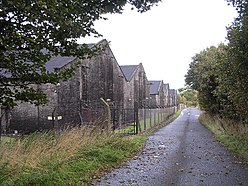Wilderness Plantation was the site of a Roman fortlet on the Antonine Wall in Scotland.[2]
| Wilderness Plantation | |
|---|---|
 Bonded warehouses near the site of the Roman Fortlet[1] | |
| Founded during the reign of | Antoninus Pius |
| Place in the Roman world | |
| Province | Britannia |
| Location | |
| County | East Dunbartonshire |
| Country | |
| Site notes | |
| Discovery year | 1965 |
| Condition | under crops |
| Excavation dates | 1965, 1966 |
The line of the Antonine Wall runs roughly parallel between the River Kelvin to the north and the Forth and Clyde Canal to the south.[3]
The site, like several others along the wall and beyond, was found by aerial photography, this discovery being reported in October 1965.[4] Following this Wilkes excavated in that year and the following one.[5] He approved of the term "interval fortlet" to describe this and other fortlets like Duntocher and Glasgow Bridge.[6]
The neighbouring forts to this fortlet are Balmuildy in the west and Cadder in the east.

No coinage has been recovered nor are there any inscriptions from the fortlet although a single coin was picked up at Wilderness West.[8]
Many Roman forts along the wall held garrisons of around 500 men.[9] Larger forts like Castlecary and Birrens had a nominal cohort of 1000 men[10] but probably sheltered women and children[11] as well although the troops were not allowed to marry.[12] There is likely too to have been large communities of civilians around the site.[13]
